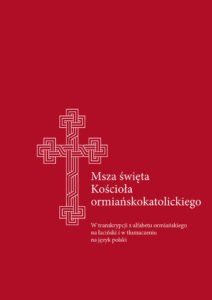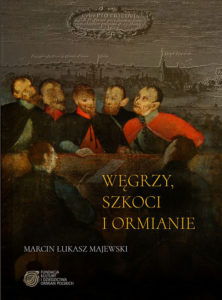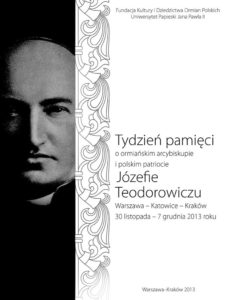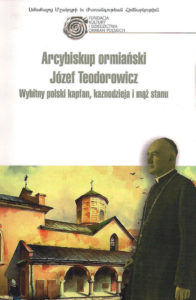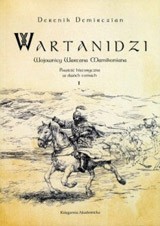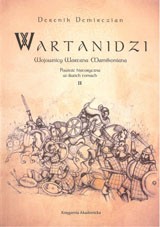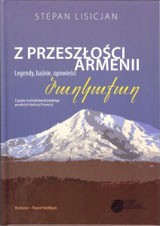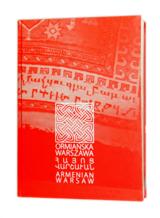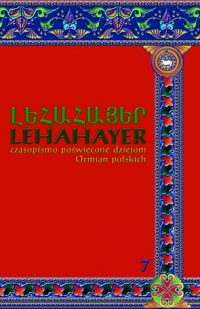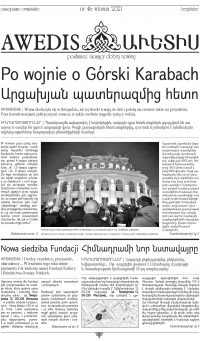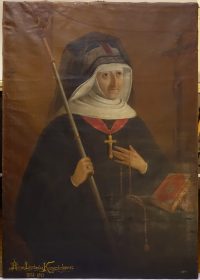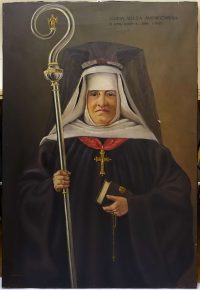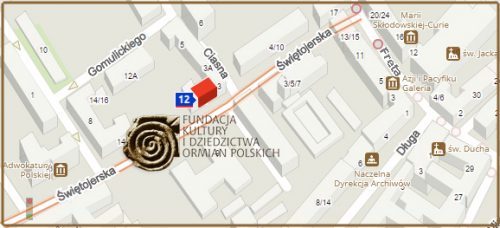GALLERY
PUBLICATIONS
NEWS
Consecutive 48th number of “Awedis” – Autumn 2021
 The 48th autumn number of “Awedis” has just appeared – Autumn 2021. In the opening article Editor in Chief writes :
The 48th autumn number of “Awedis” has just appeared – Autumn 2021. In the opening article Editor in Chief writes :
Dear Readers,
On September 27, a year passed from the Azerbaijani attack in Nagorno-Karabakh and the beginning of the 44-day war in which at least 7,000 soldiers and civilians were killed. Thousands of other people had to flee the battlefields to seek refuge in Armenia or abroad. The Azerbaijani side was actively supported by Turkey with equipment as well as military personnel. In June this year, Turkish President Recep Tayyip Erdogan visited the occupied areas of Arcakh and the city of Susha. He also signed a new alliance pact with Azerbaijan. Thus, according to some commentators, Azerbaijan entered the road of vassalage by Turkey. Meanwhile, the world seems to have forgotten about this war. An example can be Euro 2020 matches that were played in Baku. Football emotions were supposed to cover the recent aggression and casualties.
But the Armenians in Poland and in the world have not forgotten. This year, despite of the 30th anniversary of Armenia’s independence, the main topic is still war and its consequences. Instead of celebrating, it was laying of wreaths and burning candles. Charity actions aimed at supporting people affected by the war are still being undertaken, such as auctions of paintings (p.14) or excursions for children from Armenia (p.9). Polish Armenians want to commemorate the victims with monuments hence a new khachkar in Bialystok.(p.2)
A kind of consolation was the fact that in the last quarter the number of cases of covid 19 decreased and it was possible to return to a more or less normal rhythm of life.Armenian Days in Gdansk (p. 1) or church celebrations could not take place under lockdown conditions. Therefore, we hope that the next autumn wave of covid 19 cases will not be as serious as last year one and that next year will be considered as free of the pandemic.
Editor’s Office
We invite you for reading; Awedis
Vernissage of Exhibition of Portraits of Armenian Abbesses
Exhibition of portraits of Abbesses-the Benedictine nuns “Women with Crossiers” – open
 For over 70 years, the portraits were rolled up in the convent’s attic. The Foundation for the Culture and Heritage of Polish Armenians received paintings from Benedictine Sisters from Wolów and thanks to the funds obtained 7 paintings have already undergone thorough conservation. The opening of the Exhibition of the Portraits of Abbesses, due to the large number of invited guests, took place in the Cathedral of St. John the Baptist. There were three lectures on the agenda of the meeting. There were as well performances of the ancient music ensemble “La Tempesta” conducted by Jakub Burzynski. The first speaker was to be Reverend Prof. dr Jozef Naumowicz. Unfortunately, his illness prevented him from participating in the opening of the exhibition. However, he found a worthy replacement in the person of Prof. Dr. Krzysztof Stopka from Jagiellonian University. After the lecture on the Armenian Catholic rite, the musicians performed in a beautiful arrangement the song “Surb Surb” (Swiety Swiety) (Holy Holy).-
For over 70 years, the portraits were rolled up in the convent’s attic. The Foundation for the Culture and Heritage of Polish Armenians received paintings from Benedictine Sisters from Wolów and thanks to the funds obtained 7 paintings have already undergone thorough conservation. The opening of the Exhibition of the Portraits of Abbesses, due to the large number of invited guests, took place in the Cathedral of St. John the Baptist. There were three lectures on the agenda of the meeting. There were as well performances of the ancient music ensemble “La Tempesta” conducted by Jakub Burzynski. The first speaker was to be Reverend Prof. dr Jozef Naumowicz. Unfortunately, his illness prevented him from participating in the opening of the exhibition. However, he found a worthy replacement in the person of Prof. Dr. Krzysztof Stopka from Jagiellonian University. After the lecture on the Armenian Catholic rite, the musicians performed in a beautiful arrangement the song “Surb Surb” (Swiety Swiety) (Holy Holy).-
The second speaker was Dr. Andrzej A. Zieba also from the Jagiellonian University. He spoke about the convention of the Armenian Benedictine Sisters and the gallery of portraits of abbesses. Finally, the head conservator of the Collegium Maius University Museum in Krakow, Joanna Polesch told about the course of research and discovered some secrets of image conservation
The musicians performed three times presenting great ancient music – 5 singers and 2 instrumentalists – positive and chitarone. After the musicians’ final performance, all the participants of said event went to the Museum building /which was situated next to the Cathedral/ to visit the said Exhibition . read more…
On Popularizing of the Polish Armenians History by Pawel Grzesik in the Armenian Journal “Aravot”
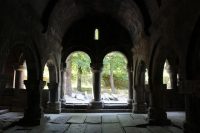 The author of the article is Astghik Kirakosyan, who currently lives in Kielce. The article will be published in several parts in Armenian and English.
The author of the article is Astghik Kirakosyan, who currently lives in Kielce. The article will be published in several parts in Armenian and English.
I am glad that the most important stages of the history of Polish Armenians – from the Middle Ages to the present day – will be presented in this form to the inhabitants of Armenia.
Paweł Grzesik
In Poland Armenians had their church and their own law. Pawel Grzesik
I met Pawel Grzesik by accident while asking for directions. An Armenian volunteer running into a historian researching Armenian history and culture on her first day in Poland, what are the odds? Pawel then invited me to the National Museum in Kielce, where I interviewed him about his work – and was pleasantly surprised. “I owe my interest in Armenian history to Grzegorz Axentowicz, who was the head of the Chamber of Crafts here in Kielce in the 1930s. One day, his son Marek donated a personal collection connected to his father to the museum, which included a lot of photos and other mementos, and I decided to write an article on Grzegorz. While writing it, I discovered that he knew about his Armenian roots and was proud of them, and that is how I became interested in the history of Armenians in Poland as well as the history of Armenia proper – all because of one man’s life story. Since then I held several lectures in Kielce’s National Museum and other places as well, on the subject of Armenians in Poland and Armenian history and heritage in general.” Pawel then shows me a presentation over a hundred slides long, which he used for his lectures at Kielce Art School three years ago, when they devoted a whole year to Armenian art and culture.
7th number of the scientific journal “Lehahayer”
The 7th issue of the Armenian scientific yearly “Lehahayer”, published by the Center of Armenian Culture Research in Poland, edited by Andrzej A.Zieba. The following articles were published in the issue;
-Armenians in Zamość in the first three decades of the city’s existence (1580-1610)
Author Marcin łukasz Majewski
– Organization of crafts and trade in the Armenian commune in Stanisławów in the 17th and 18th centuries
Author Andrzej Gliński
-“Who plays with what and with what lives”. Armenian professions from Kuty nad Cheremosz compared to other nations at the end of the 18th century
Author Franciszek Wasyl
-The idea of the return of Armenians from dispersion to their national homeland in the light of Robert Bogdanowicz’s memorials of 1877 and 1884
Author Andrzej A.Zięba
-Polish-Armenian Society in Lviv (1920-1922)
Author Jakub Osiecki
-Teaching the Armenian language at the University of Lviv in 1904-1939
Author Tomasz Krzyżowski
-Czech-Armenian relations. A brief historical overview
Author Petra Kosfalova
-Foundation for the Development and Support of Armenological Studies “Aniw”. Overview of activities.
Authors Armen Checzojan and Jewgienij Gurinov
-Protection of the Armenian heritage in the activities of the Foundation of the Heritage and Culture of Polish Armenians
Author Maria Ohanowicz-Tarasiuk
-Wartan R,Grigorian (1929-2019) in Memoriam ,
Author Aram Grigorian
-Wartan Rubenowicz Grigorian (1919-2019). Historian, armenologist, publicist, collector of old Armenian manuscripts; Memories of Wartan Grigorian
Author Andrzej Pisowicz
The publication was published thanks to a grant from the Lanckoroński Foundation and funds allocated to the statutory activity of the Faculty of History of the Jagiellonian University in Krakow.
Publication about the Lviv Archdiocese of the Armenian Catholic Rite – Awarded
 We are pleased to inform you that on the basis of the decision of the Award Chapter of the “Przegląd Wschodni” (“Eastern Review”) , the award in the ”Dzieła Krajowe”(“National Works”) category for 2020 was granted to the book;
We are pleased to inform you that on the basis of the decision of the Award Chapter of the “Przegląd Wschodni” (“Eastern Review”) , the award in the ”Dzieła Krajowe”(“National Works”) category for 2020 was granted to the book;
“Lviv Archdiocese of the Armenian Catholic Rite – in years 1902-1938”
Author Tomasz Krzyżowski
We received this great news from the publisher – the Księgarnia Akademicka (Akademicka Bookshop) in Krakow.
A comprehensive publication by Dr. Tomasz Krzyzowski entitled “Lviv Archdiocese of the Armenian Catholic Rite – in years 1902-1938” was presented by Dr Andrzej A.Zięba in the following way ;
The Armenian Catholic Church in Poland under the leadership of Archbishop Jozef Teodorowicz experienced a revival in the first four decades of the 20th century.
Worth emphasizing were the first media in its history (magazines, radio broadcasts), the renaissance of lay organizations of faithful in a modern form, a magnificent cathedral, in which the sacred elements received an extraordinary artistic creation.
There has been a renewal of contacts with the mother community of Armenian Catholics in other countries. Mission plans and the vision of mission in the Polish society and towards Armenia are undeniable achievements that could bring good in various national Armenian, religious, Catholic and ecumenical dimensions.
As we know, this did not happen because of the hecatomb that this Church and its faithful experienced during and after the Second World War.
These achievements were commonly attributed to the Archbishop, a man of great personality and prestige, exceeding confessional boundaries.
And it was undoubtedly a Church renewed by him, but not alone.
The book by Tomasz Krzyzowski supplements our knowledge about the sources and directions of the revival, showing how the structures of this Church, its institutions, priests, the religious order and the faithful operated.
The author has shown great skill in the process of research and analysis of sources. He produced a reliable, data-rich, well-composed monograph.
It is a faithful historiography reconstruction of the construction process linking the mystical with the human, the latter of which was interrupted by an inexhaustible history.
A richly illustrated book of over 700 pages was published by the Krakow Center for Research on Armenian Culture in Poland as the third volume in the Lelehayer Library series.
The publication for printing was prepared by Ksiegarnia Akademicka and co-financed by the Foundation of the Culture and Heritage of Polish Armenians with a grant from the Minister of the Internal Affairs and Administration.
To purchase the book, please contact Ksiegarnia Akademicka ; https://akademicka.com.pl/.
46th spring number of “Awedis”
The 46th spring number of “Awedis” has just appeared. In the article of Editor in Chief we read:
The war in Arcach ended with the November truce, but not everyone agreed with its arrangements. Protests in Armenia continue to this day. Demonstrators and part of the army are demanding the Prime Minister’s resignation and the revision of the armistice decisions.
But war is, apart from the loss of territories, the death of soldiers and civilians, thousands of wounded and refugees. We write about some of the effects of the war on pages 1-3. On page 7, however, Konrad Siekierski describes, using the example of one region adjacent to Karabakh, how quickly what has been built laboriously by the Armenians since the previous war can be destroyed.
In Poland, in pandemic conditions, traditional community meetings are not held and masses are usually celebrated without the participation of the faithful. They are broadcast online. However, one event is extremely important to us – it is a success in gaining a new location for our Foundation. A larger place in a perfect location will allow us to protect the collections even better than up to now and organize more popularizing enterprises in the future.
On this occasion, we would also like to remind you what the Foundation team achieved and what tasks it accomplished last year.
Due to the lack of events, we focus on history and tradition.
We also recall last year’s Armenian jubilees too.
We invite you for reading. Do pobrania (downloadable)
Poland Provides Humanitarian Aid For Armenia
Thanks to the joint efforts of the Chancellery of the Council of Ministers, the Ministries of Foreign Affairs and National Defense and the Governmental Agency of Strategic Reserves on April 15, a plane with humanitarian aid for Armenia departed from Krakow’s Balice airport.
This message was announced by the Vice-Minister of Foreign Affairs, Pawel Jablonski, the National Coordinator for development cooperation.
-Today, Poland, once again fulfills its duty towards people affected by the humanitarian crisis. We share what we can with a country that has found itself in a difficult situation due to the aftermath of the Gorny Karabakh conflict. Responding to the humanitarian appeal of the Government of Armenia we provide the civilian population affected by the armed conflict with the most urgent help; bedding, blankets, towels, electronic thermometers, disinfectants, and blood pressure gauges. …
Poland systematically provides aid to people in countries affected by humanitarian crisis. Recently, it has supported Belarus, Ukraine, Moldova, Kazakhstan and Uzbekistan. Such help was also provided to Kyrgyzstan, Tajikistan, and Ethiopia, Sudan due to the floods, as well as Lebanon after the explosion in the port of Beirut in August 2020.
GIFTS FROM THE CONVENT IN WOŁÓW
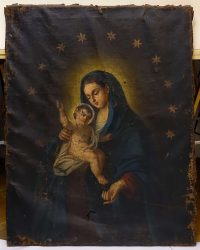 On January 10 2021, the Benedictine Sisters from Wołów, who are the heiresses of the Benedictine Sisters from Lviv gave the Foundation of the Culture and Heritage of Polish Armenians consecutive extremely valuable gift. These are the remaining 4 portraits of the Lviv Benedictine abbesses and the image of the Mother of God with the child. The portraits present the first abbess Marianna Nersewiczówna and three other abbess nuns Anna Ludwika Krzysztofowiczówna, Kajetana Rozalia Sarkisiewiczówna and Janina Alojza Janowiczówna. These four paintings complement the collection of 11 existing and preserved portraits of the abbesses of the Primate Benedictine convent from Lviv. Previously, we received 7 paintings from the sisters from Wołów, which have already undergone specialist research and conservation, thanks to that they regained their former splendor and retained all traces of the passage of time since their creation.
On January 10 2021, the Benedictine Sisters from Wołów, who are the heiresses of the Benedictine Sisters from Lviv gave the Foundation of the Culture and Heritage of Polish Armenians consecutive extremely valuable gift. These are the remaining 4 portraits of the Lviv Benedictine abbesses and the image of the Mother of God with the child. The portraits present the first abbess Marianna Nersewiczówna and three other abbess nuns Anna Ludwika Krzysztofowiczówna, Kajetana Rozalia Sarkisiewiczówna and Janina Alojza Janowiczówna. These four paintings complement the collection of 11 existing and preserved portraits of the abbesses of the Primate Benedictine convent from Lviv. Previously, we received 7 paintings from the sisters from Wołów, which have already undergone specialist research and conservation, thanks to that they regained their former splendor and retained all traces of the passage of time since their creation.
The handing over of these portraits is a historic event for the Foundation.
We obtain therefore one of the most valuable artifacts of the bygone era, commemorating the convent of the Armenian Benedictines and at the same time a unique collection of paintings, giving an overview of the changes in the painting of that time.
The agreement and the respective protocol were signed by Sister Maria Danuta Trybula, Superior of the Co
nvent and Maria Ohanowicz-Tarasiuk, President of the Board of the Foundation. Mrs Romana Obrocka, a frequent visitor to this place, also participated in the act of handing over of the paintings.
During the meeting, Sister Maria showed us a beautiful reliquary with the remains of Saint Rypsina and Saint Benedict, and the original crosier that can be seen in the three latest portraits of the abbesses . We also had the opportunity to visit the convent chapel.
We would like to express our sincere thanks once again to the Sisters for their wonderful gift for the Foundation. Thanks to this decision, these portraits, priceless for the history of the Benedictine convent, will be saved from degradation caused by the passage of time and will regain their former glory.
- Marianna Ksawera Nersesewiczówna (1701-1710)
- Anna Ludwika Krzysztofowiczówna (18-39-1843)
- Kajetana Rozalia Sarkisiewiczówna (1845-1893)
- Janina Alojza Janowiczówna (1895-1927)
NOVELTIES FROM THE FOUNDATION OF CULTURE AND HERITAGE OF POLISH ARMENIANS
Dear readers, friends and donors,
There have been many changes in the Foundation at the beginning of this year.
We will resign from the services of the former bank. Currently it is exclusively BNP Paribas – account number where payments for statutory purposes can be made is; 35 1600 1462 1890 8960 3000 0001
Another fundamental change is that in the 15th year of its activity, the Foundation moves to a new premises
that meets our needs and expectations.
Our new address is; ul. Świętojerska 12, 00-236 Warszawa (12, Swietojerska str., 00-236 Warsaw)
– near tourist routes – Nowe Miasto (New Town), 150 m from Freta Street.
The new headquarters is located on the ground floor with an entrance directly from the street. The space at our disposal will allow us to devote it partially for the generally available exhibitions of our museum and archives.
It is apparent that the implementation of these wonderful plans will be dependent on obtaining the necessary resources. However, we are full of optimism that everything will turn out to be successful. We believe that in a few months we will be able to host our friends, supporters, people interested in our collections and tourists visiting Warsaw.
AGBU 2020 GLOBAL RUN FOR LEBANON
Armenian General Benevolent Union (AGBU) was established in Egypt in 1906
as non –profit organization. With the advent of World War II, the headquarters of the organization moved to New York. European headquarters of AGBU are in Brussels.
Recently, this organization has been particularly active in helping the victims of the August explosion in Beirut.
A last month catastrophic explosion at the Beirut port took the lives of many men , women and children. A lot of people were injured. It destroyed and damaged many living compounds as well as destroyed many businesses.
The AGBU’s many years of experience in providing humanitarian aid helped
in urgent organization of immediate aid for Lebanon, where, as we know,
a large Armenian Diaspora lives.
The AGBU 2020 Relief Fund for Lebanon has been established- to the Aid of Thousands. Staff and volunteers are working around the clock to deliver urgent need throughout hardest hit areas. Mobilization of volunteers was carried out as far as task force , hotline, welcome center, clean-up are concerned. Other ranges of activities concerned home repairs and reconstruction ; assessments, funding, rebuild for 500+ homes (reconstruction has already begun).
Food Support Programs: monthly food provisions for 5,000+Armenians as well as prepared meals helping non-Armenians.
Medical Aid and Counseling: dispensaries providing medical aid to Armenians and some non-Armenians, support programs, trauma counseling for youth.
 AGBU’s Run for Lebanon
AGBU’s Run for Lebanon
Within the action Lebanon AGBU also proposed the organization of 10 K Global Run on October 25 this year.
The principal premises for this event are as follows;
AGBU 10 K GLOBAL RUN , Marketing and Promotions – September
/Some details from AGBU Brussels websites are quoted below in the text/
Phase 1
RECRUIT▪Globalemailblastandsocialmediacampaign▪Chapters/YPs/Partners use marketing materials to encourage sign-ups (email blasts and social media campaigns -ongoing)▪Chapters/YPs/Partnersactively recruit local runners/fundraisers▪Runners (Fundraisers) startsoliciting personal network for donations
Phase 2
D O N A T I O N S Global and Europe recruiting continues as needed▪Globalemail blast and social media campaign encouraging donations▪
Chapters/YPs/Partnersencourage local donors to support efforts of local runners/fundraisers▪Chapters/YPs/ Partnersencourage their runners to fundraise actively throughout this period and to cheer on their efforts.
 RUN – Runners are invited to run/walk on their own and at their own pace on October 25,2020 where ever in the world they are.
RUN – Runners are invited to run/walk on their own and at their own pace on October 25,2020 where ever in the world they are.
CELEBRATE – All are invited to take part in the post-run celebrations on October 25th
Organizers suggest to take advantage of the posts texts in media ,such as;
Suggestion 1:We need you to help raise funds for Lebanon. Anyone can participate. Walk, Run, or Jog! Sign up to help feed those in need.
Suggestion 2:Help us feed those most in need in Lebanon. You can raise funds by joining the 10K Global Run. It’s easy -walk, jog, run. Anyone can participate.
Suggestion 3:Walk, jog or run to raise funds for Lebanon relief. You can make a difference by joining our 10K Global Run
As for the banners or flags used during the event, the organizers propose to use specific graphic solutions which are available on the websites of AGBU BRUSSELS.
In general, the event is described in detail on the internet and if you are willing to participate, you will need to refer to the details placed there.


